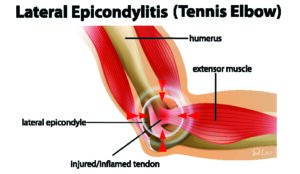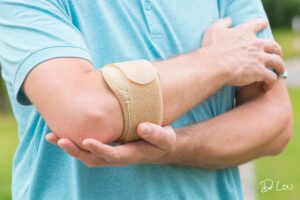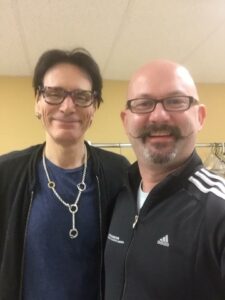Lateral Epicondylitis – Guitar Elbow – Tennis Elbow
Cause. Solution. Healing Plan Execution.
Much like tennis players who put tremendous repetitive strain on their elbows, musicians often suffer from “tennis elbow.” Musicians who play guitar, bass, banjo, ukulele, merlin, lute, or other stringed instruments, push their strumming elbow and connecting ligaments, tendons, and muscles to the limit, often leading to painful inflammation, restriction, and inability to play. If caught early, understood, and strategically addressed, the dysfunction that causes the inflammation and pain can be addressed, getting you back to playing while getting stronger and more resilient.

This is where lateral epicondylitis hurts! Do you have it? Do you need help? Are you at risk of losing your ability to play? Call Dr. Lou at (207) SPINAL 1. Telechiro available!
PRMD’s or playing-related musculoskeletal disorders are common in string players of all kinds. They tend to build over a long period of time with repetitive stress, and then, seemingly out of nowhere, a “straw” breaks the camel’s back and you are unable to play comfortably, or at all. If this type of injury gets out of control, injections, medications, and even surgery may be recommended. Most musicians I work with can neither spare the recovery time nor risk their futures as musicians if something goes wrong or gets worse. It’s often a life or death of the music situation. The first thing to remember though is that this doesn’t happen overnight and even with perfect form, you can overuse your body. If you are experiencing pain, tenderness, and swelling over the lateral elbow, look back at your playing history and ask yourself, “have I been playing a lot? Have I just started playing again after a hiatus?” If so, you may have lateral epicondylitis.
Lateral epicondylitis is common in strummers of string instruments! Dr. Lou is an expert in musician injuries and healing from a non-invasive chiropractic perspective. “Telechiro” with Dr. Lou is available anywhere in the world.
Lateral epicondylitis may be diagnosed in a person, over the phone, or through video chat. During the time of COVID-19, people have been at home and playing more music. Unable or unwilling to step foot in a medical facility is understandable. Evaluation over a video conference call with a strategic home care plan may be the safest and fastest way to get relief from this problem.
While they may seem like common knowledge and a bit mundane, the following recommendations pose little to no risk for further injury and would not require a diagnosis to get started.
Rest. If you are willing to take a week or two off, practice your music in your head. If you are not willing to rest, be more conscious of your playing, don’t push too hard, and do the following.
Heat and stretching the area before playing (warm it up) to improve blood flow and reduce inflammation going into practicing or playing.
Ice the area after playing to reduce inflammation (15-20 minutes).
Massage your elbow muscles gently for 5 – 10 minutes daily.
Wear a wrap to compress your elbow and forearm strumming muscles. (think tennis elbow wrap from a sporting goods store)

This musician is wearing the brace that you may need. Compress the inflammation, reduce the pain.
Remember that you are a “musical athlete.” If you treat yourself like you are the musician equivalent of Serena Williams or Tiger Woods, you’ll fare much better over time and remain “in the game” with fewer setbacks.
Get help if home care isn’t working. A musician health specialist will be able to help you navigate your injury or disability. They will get you back to playing sooner. They will reduce your risk of pain and losing your ability to play.
Dr. Lou Jacobs is a chiropractor – acupuncturist in Portland, Maine who has been specializing in musician injuries and crew injuries for 20 years. Dr. Lou is available for telemedicine consultations for music-related injuries and health problems. Among some of those he has permission to mention, Dr. Lou has worked with Mumford & Sons, The Pixies, Steve Vai, Tommy Emmanuel, Ziggy Marley and the Melody Makers, Blackberry Smoke, Gogol Bordello, Trey Anastasio, and Edward Sharpe and the Magnetic Zeros. PHOTOS

Steve Vai
